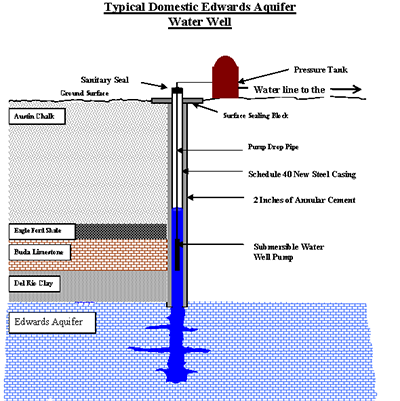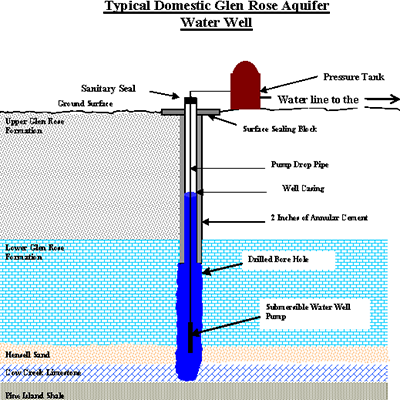New Private & Existing Domestic Wells
| Important Numbers |
| 210-233-3546 SAWS Groundwater Resource Protection Division |
| 210-207-8747 San Antonio Health Dept. |
| 210-233-2349 Questions regarding wells |
Key principles for wellhead protection for private domestic wells are as follows:
- Proper location of well (Proper sanitary control easements)
- Proper well construction
- Backflow prevention
- Keeping contaminants away from well
- Water quality analysis
- Proper closure of abandoned wells
San Antonio City Code mandates that the Groundwater Resource Protection Section of the San Antonio Water System be the permitting authority for all water well activities within San Antonio city limits and SAWS service area. SAWS’ Groundwater Resource Protection Section Water Well Permitting Procedures require that all water wells are constructed and completed in accordance with state and local specifications to ensure the protection of our groundwater sources.
Proper Well Location and Construction for New Private Domestic Wells
Duties of SAWS Groundwater Resource Protection Section are to:
- Inspect the property where any water well is to be drilled and refuse the issuance of a permit to drill a well when the proposed location does not meet with all the conditions as referenced under city code and state guidelines.
- Ensure that sanitary control conditions and distance requirements are adhered to.
- Require that all wells be constructed and cased so that water from one stratum cannot come in contact with water from another stratum.
- Require a 2-inch annulus between the borehole and the casing from the top of the water-bearing formation to the surface. This is to ensure the cement, which fills the annulus, prevents the possibility of any surface contamination.
- Require the casing to be set in the top of the stratum from which water is to be taken and shall be cemented from the top of the stratum to the surface in place by a suitable method approved by the Water Quality Division.
- Require for Edwards Aquifer wells new standard schedule 40 steel casing to be used.
- Require for all other wells, a minimum of 40 feet of new schedule 40 steel casing to be used. (Surface to 40 feet.)
 |
 |
| Click for pdf view | Click for pdf view |
Wellhead Protection Recommendations for Well Owners
Keeping Contaminants Away from Wells
To reduce the chance of contamination of the well, keep the surrounding areas free of potential source of contamination, such as:
- Pesticides
- Herbicides
- Petroleum products
- Fertilizer
- All household chemicals (such as cleaners, solvents, paints, etc.)
- Animal or fowl enclosures
If you change the oil in your vehicles yourself, be sure to collect the oil in a container and carry it to a collection center for recycling. Never dispose of the oil by dumping it on the ground.
Do not mix pesticides near a well. Keep all such activities at least 100 feet from the well.
A well owner should inspect their well often to insure its integrity is maintained.
Backflow Prevention
- Hazards
- Prevention
One of the more hazardous situations that can occur with a private well is the possibility of backflow or back-siphoning.
When a well shuts off unexpectedly, such as with a power outage or lightning damage, backflow usually occurs. Most private wells have a single check valve that should prevent the water in the column of pipe from falling back into the well, creating suction throughout the home’s water system when an unexpected problem arises. Despite this safeguard, the check valve could leak causing the water to flow back into the well. If this happens, and the homeowner was using a hose-end device to apply fertilizers or pesticides to the lawn, a siphoning effect could be created and the chemical could end up in the homeowner’s well. Backflow can also occur in lawn sprinkler systems. If one sprinkler is in a low area that has standing water above it, this surface-contaminated water could be siphoned into the well.
The installation of a simple atmospheric vacuum breaker on each outside hose bib can prevent backflow. For sprinkler systems, the simplest and most common device installed is a double check valve backflow preventer placed between the well and sprinkler system. Injecting chemicals or fertilizers into the sprinkler system is not recommended due to the high degree of hazard to the well and homeowner.
Water Analysis
It is recommended that well owners routinely have water from their private wells tested to ensure that no contamination has occurred. All wells should be tested at least for bacteria and nitrates.
The San Antonio Health Department can test for bacteria and nitrates for a small fee.
San Antonio Testing Lab Drinking Water Bacteriology Laboratory phone number: 210-207-8887
Additional suggestions:
- Always use licensed or certified water well drillers and pump installers to construct a well, install a pump or service the system.
- Periodically check the well cover or well cap on top of the casing (well) to ensure it is in good condition.
- Take care when working or mowing around your well. A damaged casing could jeopardize the sanitary protection of your well. Don’t pile leaves or other materials around your well.
- Keep your well records in a safe place. These include the construction report (State Well Report), as well as the annual water well system maintenance and water testing results.
Abandoned Wells
Abandoned water wells or wells in deteriorated condition pose a serious threat to the Edwards Aquifer or any aquifer. Any well that has not been used for a minimum of six consecutive months, not connected to an active power source and exists in a deteriorated condition, is defined as abandoned and must be properly plugged.
Never use an abandoned well to dispose of any material.
Report any or suspected abandoned wells to the SAWS
Groundwater Resource Protection Section at 210-233-3543.
Questions regarding Wellhead Protection and the Domestic well, call Jim O’Connor at 210-233-3547.